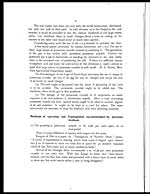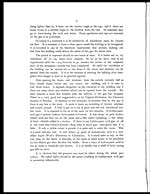Medicine - Institutions > Army health reports and medical documents > Scientific memoirs by officers of the Medical and Sanitary Departments of the Government of India > Number 38 - Preliminary report on the killing of rats and rat fleas by hydrocyanic acid gas > Preliminary report on the killing of rats and rat fleas by hydrocyanic acid gas
(13) Page 5
Download files
Individual page:
Thumbnail gallery: Grid view | List view

5
Sirrine advises 25 grammes of potassium cyanide per too cubic feet; or
for orchard trees, owing to the moisture and absorption of the evolved hydro-
cyanic acid gas, 30 grammes, i.e., about 1 oz. to 100 cubic feet.
The Government Entomologist for the Cape of Good Hope in his Report
for the year 1901 states that bugs are more refractory to the gas than any other
house insect. One ounce of potassuim cyanide to 155 cubic feet of air space
with an exposure of one hour killed 12 out of 15 bugs. The remaining 3 were
very feeble. Eggs of the bugs failed to hatch in three tests after exposure for
one hour to gas of the above strength.
He advises the use of one ounce to too cubic feet of space and an
exposure for two hours. "When there are any deep cracks or crevices in any
building to be penetrated, one ounce to 65 cubic feet of space may be used."
(2) Actual procedure to be adopted as advised in the report of the Government
Entomologist for the Cape of Good Hope for the year 1901.
The building to be fumigated is made as air-tight as possible. Arrange-
ments should be made for opening doors and windows from the outside to.
ventilate after fumigation. Each room should be fumigated separately, if
possible, but sometimes two connecting spaces may be treated as one. In
the latter case crevices and splits in doors connecting the two spaces should be
enlarged and burrows opened up. Bedding, clothing, etc., should be spread out
to let the gas get full effect on them.
The vessels in which the chemicals are to be mixed must be of such a
nature that they are not acted on by them. Their size depends on the quantity
of chemicals to be used. They must be of such a shape that the depth of
combined sulphuric acid and water will cover the cyanide put in. They may be
glazed earthenware vessels or china washhand vessels. Lead vessels are good
but heavy and soft. Enamelware till cracked acts well. Kerosine oil tins will
serve for two or three different charges. One of these tins can take a charge of
3 lbs. of potassium cyanide—the utmost that ought to be put into one vessel.
Place the vessel near the middle of the room. Measure out quantities of water,
acid, and potassium cyanide. The man who measures out the potassium cyanide
ought to handle it with rubber gloves as the salt is so poisonous. Mix the acid
into the water, at once drop in the potassium cyanide at arm's length, and run out
of the room. Many people wrap up the potassium cyanide in soft paper which
takes a few seconds to be eaten through, permitting the operator to get out of the
room before the gas is given off. The American fumigators usually lower the
potassium cyanide by means of a string and pulley from the outside after the
door of the room to be fumigated is locked. As the hydrocyanic acid gas rises,
Set display mode to: Large image | Zoom image | Transcription
Images and transcriptions on this page, including medium image downloads, may be used under the Creative Commons Attribution 4.0 International Licence unless otherwise stated. ![]()
| Permanent URL | https://digital.nls.uk/75033586 |
|---|
| Shelfmark | IP/QB.10 |
|---|---|
| Additional NLS resources: | |




